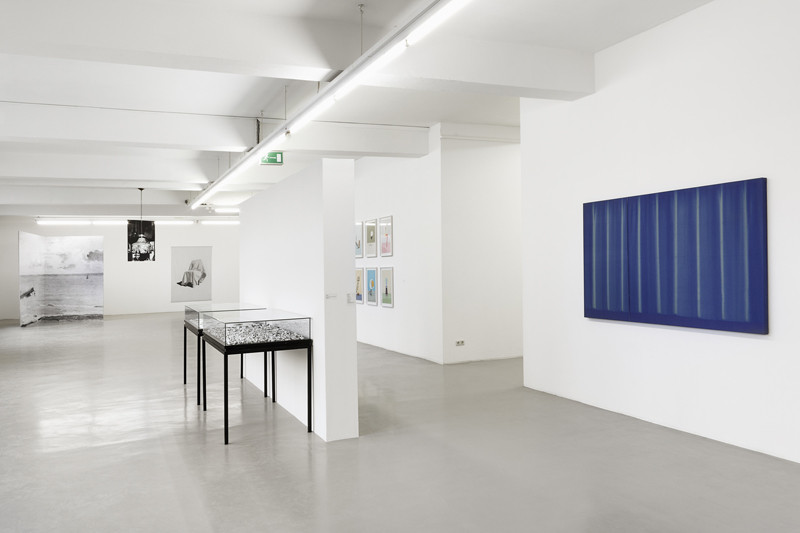Dealing with Surfaces
08 Feb - 12 Apr 2015

Exhibition view Dealing with Surfaces, GAK Gesellschaft für Aktuelle Kunst, 2015
Photo: Tobias Hübel
Photo: Tobias Hübel
Lars Bergmann, Ceal Floyer, Samuel Henne, Alexandra Leykauf, Marie Lund, Ines Meier, Jong Oh, Marlo Pascual, Ariel Schlesinger, Tillmann Terbuyken, Susanne K. Willand
Curated by Svea Kellner
“Ordinarily you have no doubts about the existence of the floor under your feet, or the tree outside the window (...)." [1] - the spatial, three-dimensional arrangement of our environment is a reality that we take for granted. Our everyday life is based on the assumption that "(...) the world, like any satisfactory perception, is organized in a meaningful, clear, coherent and holistic fashion." [2] But how do we know that what we perceive visually is actually there and indeed true to what we see? Could things be fundamentally different from how they appear to us? Can the world be considered and understood in ways beyond established schemes and classifications?
The exhibition Dealing with Surfaces brings together works by contemporary artists from a younger generation which explore the boundaries between surface and space. These works explore the "in-between", the critical points, transitions, shifts and mutual penetrations. How can the character of object and image be grasped, where do the boundaries lie, when do they dissolve? Because the works on display elude a distinct identifiability, undermine artistic categories and show discrepancies between representation and the real, they put into perspective apparent certainties about the nature of things and question mechanisms of visual perception in terms of "seeing seeing". [3]
In different media and formats, the positions presented in the context of Dealing with Surfaces examine the tension between visuality and spatiality as well as their perception and representability. Installation, painting, photography, projection or sculpture coalesce in a hybrid way, intertwine and ask for their specific way of reception. Surfaces are folded, space is smoothened, layers disappear or are manifolded. Impressions arise in the eye of the spectator and evaporate the next moment.
[1] Thomas Nagel: What Does It All Mean? A Very Short Introduction to Philosophy, Stuttgart 1990. p. 9.
[2] Nina Zschocke: Der irritierte Blick. Kunstrezeption und Aufmerksamkeit (The Irritated Gaze. Art reception and Attention), Munich 2006. p. 80.
[3] ibid., p. 151.
Curated by Svea Kellner
“Ordinarily you have no doubts about the existence of the floor under your feet, or the tree outside the window (...)." [1] - the spatial, three-dimensional arrangement of our environment is a reality that we take for granted. Our everyday life is based on the assumption that "(...) the world, like any satisfactory perception, is organized in a meaningful, clear, coherent and holistic fashion." [2] But how do we know that what we perceive visually is actually there and indeed true to what we see? Could things be fundamentally different from how they appear to us? Can the world be considered and understood in ways beyond established schemes and classifications?
The exhibition Dealing with Surfaces brings together works by contemporary artists from a younger generation which explore the boundaries between surface and space. These works explore the "in-between", the critical points, transitions, shifts and mutual penetrations. How can the character of object and image be grasped, where do the boundaries lie, when do they dissolve? Because the works on display elude a distinct identifiability, undermine artistic categories and show discrepancies between representation and the real, they put into perspective apparent certainties about the nature of things and question mechanisms of visual perception in terms of "seeing seeing". [3]
In different media and formats, the positions presented in the context of Dealing with Surfaces examine the tension between visuality and spatiality as well as their perception and representability. Installation, painting, photography, projection or sculpture coalesce in a hybrid way, intertwine and ask for their specific way of reception. Surfaces are folded, space is smoothened, layers disappear or are manifolded. Impressions arise in the eye of the spectator and evaporate the next moment.
[1] Thomas Nagel: What Does It All Mean? A Very Short Introduction to Philosophy, Stuttgart 1990. p. 9.
[2] Nina Zschocke: Der irritierte Blick. Kunstrezeption und Aufmerksamkeit (The Irritated Gaze. Art reception and Attention), Munich 2006. p. 80.
[3] ibid., p. 151.
